Welcome to this special edition of Neurology News Network. I’m Marco Meglio. Please excuse our appearance this week as a majority of the US workforce, including the NeurologyLive team, moves to working remote as we come together to help reduce the spread of the novel coronavirus.
Recently published data from the phase 3, parallel-group, double-blind, placebo-controlled RELIEF study showed that patients experiencing moderate to severe migraine attacks treated with eptinezumab (Vyepti; Lundbeck) had time to headache and symptom resolution significantly shortened. The study included 480 patients randomized to 100-mg eptinezumab or placebo, administered intravenously within 1 to 6 hours of onset of a qualifying moderate to severe migraine. Lead author Paul K. Winner, DO, director, Palm Beach Headache Center, and colleagues used time to headache pain freedom and time to absence of most bothersome symptom (MBS) as the co-primary end points. Patients treated with 100-mg eptinezumab achieved the co-primary end points of the time to freedom from headache pain and time to absence of their MBS earlier than placebo. The median time after start of infusion to headache freedom was 4 hours for eptinezumab-treated patients and 9 hours for placebo patients, while the median time to absence of MBS was 2 and 3 hours, respectively, for the same groups.
Newly published data showed that treatment with Zolgensma demonstrated age-appropriate milestone development in presymptomatic children with spinal muscular atrophy (SMA), as well as improvements in motor function in patients with SMA Type 1 not seen in the natural history of the disease.The data collected were from the phase 3 SPR1NT and STR1VE-EU clinical trials and was presented at the 7th Congress of the European Academy for Neurology (EAN). SPR1NT, an open-label, single-arm, multi-center trial, evaluated the agent in presymptomatic patients with SMA aged 6 weeks or younger with 2 or 3 copies of SMN2. The data showed that all patients (n = 14; 100%) achieved the primary end point of sitting independently for at least 30 seconds, including 11 (79%) who achieved this milestone within the World Health Organization (WHO) window of normal development.
Results from the STROKE AF trial using Medtronic’s Reveal LINQ Insertable Cardiac Monitor (ICM) found the system to significantly predict atrial fibrillation (AF) over 12 months in patients with stroke attributed to large- or small-vessel disease compared with usual care. Patients were randomized 1:1 to either the intervention group, where they received ICM insertion within 10 days of the index, or the control group, where they received site-specific usual care consisting of external cardiac monitoring, such as 12-lead electrocardiograms, Holter monitoring, telemetry, or event recorders. At 12 months, the incidence of AF was 12.1% (n = 27) in the ICM group compared to 1.8% in the control group. Additionally, the median time from randomization to AF detection was 99 days for the ICM group and 181 days for the control group.
For more direct access to expert insight, head to NeurologyLive.com. This has been Neurology News Network. Thanks for watching.



































